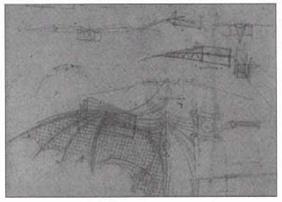Leonardo and His Flying Machines
As Leonardo’s understanding of bird flight grew, so did his visions of machines that would lift man off the ground and allow him to fly freely over the treetops. His flying machine featured complex wings and controls that fitted over the head and neck of the pilot. These cumbersome controls were meant to help a flyer control the sideways motion of the machine, much like a ship’s rudder.
One of Leonardo’s quirkier inventions was his take on the helicopter, whose design might not win any beauty contests but at least demonstrates that Leonardo understood the fluid properties of air. The main part of the machine, which never evolved beyond a drawing in a sketch book and a crude model, resembled a screw, a design that Leonardo had integrated into many of his mechanical inventions. Rather than wood or metal, the “thread” of this screw was constructed of heavy fabric that spiraled upward in a broad sweep around a vertical axle. As Leonardo sketched it, the helicopter was meant to be powered by human muscle; a pilot was to turn the central axle rapidly enough to force air down the sloping spiral of fabric, and therefore drive the machine upward.
Leonardo’s machine was far too heavy to have been able to fly under human power alone, but it inspired a lot of imitators—including the Wright brothers, in an indirect way, as we’ll see in Chapter 2, “The Bishop’s Boys: Wilbur and Orville Wright”.
|
Plane Talk Leonardo designed an enormous device called an "ornithopter" that featured four flapping wings attached to levers. He intended the human pilot to pump the levers fast enough to lift the machine off the ground. Judging by the enormous physical demands Leonardo’s machines placed on their pilots, the master engineer might have been better suited to a career as a designer of workout equipment! |
The First Flight?
Legends have grown up around Leonardo that tantalize us even today, though his role as an aviation inventor has been overshadowed by his breathtaking paintings and his artistic studies of the human body. One legend that invites the wildest speculation is a story involving one of his many followers and students.
According to the tale, one of Leonardo’s assistants was so impressed by the master’s flying machine that he strapped himself to it and leaped from a tall cliff. There is no account of the flight—if it can be called that—but only of the outcome: The wouldbe flyer hit the ground hard and was seriously injured. It’s interesting to think that if the story is true, and if the flyer glided even slightly outward, then the tiny village of Vinci became on that sunny Florentine morning the site of the first human flight.
|
|
Leonardo’s wing designs show an amazing level of detail, and
strongly resemble bat wings.
|
|
Plane Talk
If the legend of Leonardo’* impetuous test-pilot assistant it true, the young man might have appreciated another of Leonardo’s inventions—the parachute. Or maybe not In his notebook, Leonardo drew a detailed sketch of a pyramid-shaped apparatus that dangled its wearer below it just as modern parachutes function. But rather than the light, billowy hemisphere of fabric used in parachutes of the twentieth century, Leonardo’s parachute featured a sturdy pyramidal wood frame covered with heavy fabric. The whole thing was gigantic, meaning that it would have been absurdly heavy. No one is known to have tested the parachute, and considering Leonardo’s scant success with his flying inventions, it’s probably a good thing.
All in all, Leonardo’s aircraft designs were startlingly fresh and innovative. But it was the world’s ill fate that Leonardo was bom too soon. Europe of the fifteenth and sixteenth centuries based its industry on wood and metal. Manufactured goods may have been durable, but they were also heavy. Leonardo must have known that each of his flying machines would ultimately fail. We can only imagine the frustration he must have felt; he was perhaps the first man ever to possess the engineering genius that could have permitted people to fly, but he was trapped by relatively primitive earth-bound technology. He died without ever seeing his inventions work the way he imagined they would.














